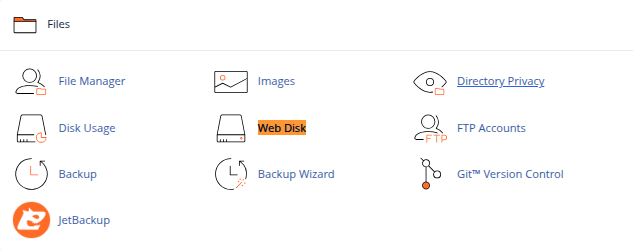Managing website files doesn’t always have to involve FTP clients or logging into cPanel manually. One of the most underrated features of cPanel is Web Disk, which allows you to map your hosting account as a network drive on your computer. This means you can drag, drop, copy, or edit files directly from your desktop, just like managing files in any folder. In this guide, we’ll show you how to set up and use Web Disk for secure file management.
What Is cPanel Web Disk?
Web Disk is a file management feature in cPanel based on the WebDAV (Web Distributed Authoring and Versioning) protocol. It allows users to:
- Upload and manage website files securely
- Mount the server’s home directory as a network drive
- Share access with additional users
- Avoid the hassle of FTP software
It’s ideal for users who prefer working in a file explorer interface or need quick file access across devices.
Benefits of Using Web Disk
- Convenient Access: Access your files as if they were local folders.
- Secure Transmission: Use HTTPS to encrypt data in transit.
- Multi-Device Support: Works with Windows, macOS, Linux, and mobile platforms.
- User Management: Create additional Web Disk accounts with restricted access.
Step-by-Step Guide to Using cPanel Web Disk
Step 1: Log in to Your cPanel Account
Go to your hosting provider’s cPanel login page and sign in with your credentials.
Step 2: Locate and Open the Web Disk Feature
Once logged in:
- Scroll to the Files section.
- Click on Web Disk.

This will bring up the Web Disk interface.
Step 3: Create a Web Disk Account (Optional)
By default, your cPanel account can be used to connect via Web Disk. However, you can also create additional users:
- Under Create an Additional Web Disk Account, fill in:
- Username
- Domain (if multiple)
- Password
- Directory (e.g.,
public_html/uploads) - Permissions (Read-Write or Read-Only)
- Click Create.

This is useful when delegating access to team members or clients with limited file needs.
Step 4: Download the Configuration Script
Scroll down to Main Web Disk Account or your custom user and click Configure Client.
- Select your Operating System.
- Download the Web Disk configuration script provided.
This script helps set up the network drive on your system.
Setting Up Web Disk on Different Operating Systems
For Windows Users:
- Run the configuration script you downloaded.
- Windows may prompt for credentials use the Web Disk username and password.
- A network location will be mounted under “This PC,” named after your domain or Web Disk account.
Note: On Windows 10 or later, you may need to enable Basic Authentication in the Windows registry. cPanel provides instructions for this in the same area where you downloaded the script.
For macOS Users:
- Open Finder.
- Click Go > Connect to Server.
- Enter the Web Disk URL, typically in the format:
https://yourdomain.com:2078 - Authenticate with your Web Disk username and password.
- The server will mount as a drive in Finder.
For Linux Users:
Use Nautilus, Dolphin, or other file managers:
- Choose Connect to Server.
- Enter the URL:
davs://yourdomain.com:2078 - Provide login credentials.
- Mount the drive.
Best Practices for Secure Use
- Always use HTTPS: Avoid unencrypted connections (port 2077) and ensure port 2078 is used.
- Set strong passwords: Especially for additional Web Disk accounts.
- Limit permissions: Assign Read-Only access when appropriate.
- Disable unused accounts: Remove temporary or unused Web Disk users to reduce exposure.
- Monitor usage: Use cPanel logs or security tools like Imunify or CSF to track access.
Troubleshooting Tips
- Firewall Blocking Port: Ensure ports 2077 (HTTP) and 2078 (HTTPS) are open on your server firewall.
- Authentication Fails: Double-check username, domain, and password. Also ensure special characters in passwords are escaped if needed.
- Drive Not Mounting: For Windows, verify that WebDAV services are enabled under “Services”.
Conclusion
cPanel’s Web Disk feature is a powerful yet simple way to manage your hosting account’s files securely from your desktop or mobile device. Whether you’re a developer, a designer, or a site owner, mapping your account as a network drive brings convenience and control to your workflow.
By taking advantage of this feature, you reduce your dependency on third-party tools, streamline collaboration, and maintain file access with minimal setup. If you haven’t used Web Disk yet, it might be time to explore this hidden gem in your cPanel dashboard.





 Samuel Lester
Samuel Lester  June 28, 2025
June 28, 2025